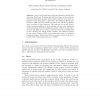Free Online Productivity Tools
i2Speak
i2Symbol
i2OCR
iTex2Img
iWeb2Print
iWeb2Shot
i2Type
iPdf2Split
iPdf2Merge
i2Bopomofo
i2Arabic
i2Style
i2Image
i2PDF
iLatex2Rtf
Sci2ools
117
click to vote
AE
2005
Springer
2005
Springer
Size Control with Maximum Homologous Crossover
Most of the Evolutionary Algorithms handling variable-sized structures, like Genetic Programming, tend to produce too long solutions and the recombination operator used is often considered to be partly responsible of this phenomenon, called bloat. The Maximum Homologous Crossover (MHC) preserves similar structures from parents by aligning them according to their homology. This operator has already demonstrated interesting abilities in bloat reduction but also some weaknesses in the exploration of the size of programs during evolution. In this paper, we show that MHC do not induce any specific biases in the distribution of sizes, allowing size control during evolution. Two different methods for size control based on MHC are presented and tested on a symbolic regression problem. Results show that an accurate control of the size is possible while improving performances of MHC.
| Added | 26 Jun 2010 |
| Updated | 26 Jun 2010 |
| Type | Conference |
| Year | 2005 |
| Where | AE |
| Authors | Michael Defoin-Platel, Manuel Clergue, Philippe Collard |
Comments (0)

